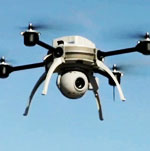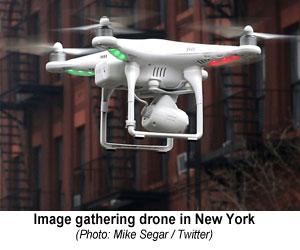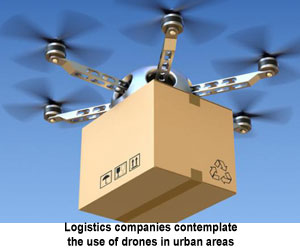
Professional drones can be bought for as little as US$1,500

FRONT PAGE
About us
 

Drones over US cities
US transportation and the economy

Worldwide | Elections | North America | Latin America | Europe | Asia | Africa |


 




 













|
|
Mayors weigh up pros and cons
as drones take off across America
By Tony Favro, USA Editor
11 June 2015: When the City Council of Ferndale, Michigan, near Detroit, proposed a law in April 2015 banning the use of drones on public property in response to the privacy concerns of some city residents, a public outcry forced council members to withdraw the ordinance. Residents with privacy concerns were far outnumbered by residents who believed that restricting the use of drones would “crush the spirit of innovation and entrepreneurship that the drone era is ushering in,” in the words of one person who spoke to the Ferndale City Council at a public hearing about the proposed legislation.
Few technologies today command the level of excitement in the United States as the one rapidly emerging around drones, or small unmanned aerial vehicles (SUAV). Leaders of American cities of all sizes view drones as a way to create jobs, serve residents, offer budget relief, and send a message that they are innovative.
 Small unmanned aerial vehicles, or those weighing less than 55 pounds (25 kilograms), are now viewed as essential to a vast array of industries, including farming and agriculture, oil and gas, construction and infrastructure development, and film and production. SUAVs—essentially small flying robots—are often safer than manned aircraft and can perform tasks like aerial photography and data collection more efficiently and with significantly lower costs than traditional methods. Small unmanned aerial vehicles, or those weighing less than 55 pounds (25 kilograms), are now viewed as essential to a vast array of industries, including farming and agriculture, oil and gas, construction and infrastructure development, and film and production. SUAVs—essentially small flying robots—are often safer than manned aircraft and can perform tasks like aerial photography and data collection more efficiently and with significantly lower costs than traditional methods.
US mayors and municipal officials are generally quiet on the issue of drones, offering neither vocal support nor opposition. Their public reticence may represent the tricky balancing act between protecting individual privacy and encouraging community economic development that drone technology represents.
On the one hand, several state and local governments have passed or are considering legislation to limit drone activities, largely due to concerns about the invasion of individuals’ right to privacy and about public safety. In late 2014, for example, California passed a law banning the use of drones to record the images and voices of people who did not give their permission for it. In New York State, several laws are pending to curtail certain types of SUAV activity. On the local government level, the City Councils of New York City, Phoenix, Arizona and a handful other cities are considering legislation to ban all commercial drone operations due to safety and privacy concerns.
On the other hand, drone technology potentially can bring significant resources to communities. The Association for Unmanned Vehicle Systems International, a non-profit advocacy group for drones and robotics, estimates that the SUAV industry could create 1,200 jobs and $600 million in economic activity in North Carolina by 2025. Other studies predict similar economic benefits for other US states and cities. The US federal government funds Centers of Excellence to develop drone technology at universities, such as Mississippi State University, and then transfer that technology to job-creating private businesses in local communities. The federal government has also set up sites to test drone technologies and capabilities at military bases, such as that outside the city of Rome, New York, thus maintaining or increasing local jobs.
Several cities also view drones as a way to improve public services at a lower cost. According to the Electronic Frontier Foundation, a nonprofit organization dedicated to defending civil liberties in a digital world, about 60 public entities in the US have applied to the federal government for permission to use drones as part of their work activities, including the Los Angeles County Sheriff’s Department and the Detroit Fire Department.
Perhaps mayors are reluctant to speak out publicly either for or against drones because they are uncertain which way the technology will go and what the full implications will be. The Federal Aviation Administration (FAA), which regulates SUAVs, issues Experimental Airworthiness Certificates to allow businesses to test practical applications of drone technology in the real world. For example, the Agency recently issued one such certificate to Amazon to begin formal testing of its planned drone package delivery service. The FAA has indicated a willingness to issue similar certificates to other organizations as well, which may increase jobs in communities that house drone industries, but which may lead to job losses in other communities. “If you don’t innovate, you are one step from extinction,” said the former Chief Information Officer of Washington, DC at a recent meeting of the Technology and Innovation Task Force of the US Conference of Mayors. The task force, chaired by San Francisco Mayor Edwin Lee, discussed drones but did not take a position on them specifically; rather the task force endorsed a general statement that “technology must be integrated in everything a community does.”
Mostly, mayors and municipal officials are awaiting direction from the federal government. As a councilwoman in Ferndale, Michigan said in response to the public outcry against that city’s attempt to ban drone flights over public property, “We should take a step back and look at what the Federal Aviation Administration does.”
 Federal approval is required to operate drones in the US. For decades, small remote control aircraft were used in limited commercial activities and were essentially unregulated by the Federal Aviation Administration. With advances in technology, the benefits and use of small unmanned aerial vehicles have skyrocketed. Three years ago, President Barack Obama signed into law the FAA Modernization and Reform Act of 2012, requiring the federal agency to integrate SUAVs into US airspace by September 2015. Federal approval is required to operate drones in the US. For decades, small remote control aircraft were used in limited commercial activities and were essentially unregulated by the Federal Aviation Administration. With advances in technology, the benefits and use of small unmanned aerial vehicles have skyrocketed. Three years ago, President Barack Obama signed into law the FAA Modernization and Reform Act of 2012, requiring the federal agency to integrate SUAVs into US airspace by September 2015.
Until formal rules for integration are established, the FAA has taken the position that all SUAV operations conducted for hire or in relation to a business or public use must obtain the agency’s approval before starting operations. As mentioned, companies can also obtain permission to research the feasibility of drone technology through the experimental airworthiness certificate process, and more than 1,000 entrepreneurs and businesses have applied for such certificates.
There are strict limitations that apply to the use of drones once federal approval is granted:
• SUAV flights can be operated only by an individual who is a certificated manned aircraft pilot. A visual observer also is required to help maintain visual contact with the SUAV for all flights.
• SUAV flights are restricted to no more than 400 feet (122 meters) above the ground, and the SUAV must remain within the visual line-of-sight of the pilot and visual observer at all times. Flights over people are limited.
• No flight may be conducted at night or in poor weather.
The rule making process tends to be lengthy in the US. In February 2015, the FAA released a draft of the proposed rules and regulations for SUAVs. The next step in the rulemaking process allows the public to submit formal written comments on the proposed rules to the FAA. The FAA is required to review all received comments and evaluate what changes, if any, are necessary before the regulations become the law of the land. The draft rules and regulations will likely change before they go into effect, probably in late 2016 or sometime in 2017.
The regulatory uncertainty has not deterred interest in drones. Experts on SUAVs generally agree that the Federal Aviation Administration’s proposed rules take into account many of the benefits of drone technology and do not unduly burden further innovation in the industry.
Speaking for many US mayors at a conference last year on advanced manufacturing, Chicago Mayor Rahm Emanuel asserted that “high-technology manufacturing,” such as robotics, “is truly reinventing America and American cities and redefining their role in the global economy.” US mayors may not be particularly outspoken on drones, but they have made it clear that they stand ready to work in partnership with manufacturers of the technology to create jobs and economic opportunities.
|
|

|































 Small unmanned aerial vehicles, or those weighing less than 55 pounds (25 kilograms), are now viewed as essential to a vast array of industries, including farming and agriculture, oil and gas, construction and infrastructure development, and film and production. SUAVs—essentially small flying robots—are often safer than manned aircraft and can perform tasks like aerial photography and data collection more efficiently and with significantly lower costs than traditional methods.
Small unmanned aerial vehicles, or those weighing less than 55 pounds (25 kilograms), are now viewed as essential to a vast array of industries, including farming and agriculture, oil and gas, construction and infrastructure development, and film and production. SUAVs—essentially small flying robots—are often safer than manned aircraft and can perform tasks like aerial photography and data collection more efficiently and with significantly lower costs than traditional methods. Federal approval is required to operate drones in the US. For decades, small remote control aircraft were used in limited commercial activities and were essentially unregulated by the Federal Aviation Administration. With advances in technology, the benefits and use of small unmanned aerial vehicles have skyrocketed. Three years ago, President Barack Obama signed into law the FAA Modernization and Reform Act of 2012, requiring the federal agency to integrate SUAVs into US airspace by September 2015.
Federal approval is required to operate drones in the US. For decades, small remote control aircraft were used in limited commercial activities and were essentially unregulated by the Federal Aviation Administration. With advances in technology, the benefits and use of small unmanned aerial vehicles have skyrocketed. Three years ago, President Barack Obama signed into law the FAA Modernization and Reform Act of 2012, requiring the federal agency to integrate SUAVs into US airspace by September 2015.